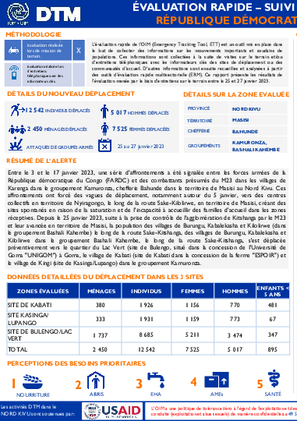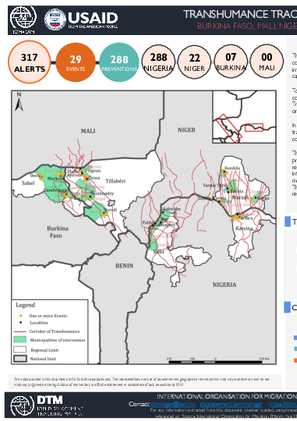-
Countries
-
Data and Analysis
-
Special Focus
-
Crisis Responses

Contact
DTM Cameroon, DTMCameroun@iom.int
Language
English
Location
Cameroon
Period Covered
Feb 05 2023
Feb 06 2023
Activity
- Mobility Tracking
- Event Tracking
Selon les informations partagées par les informateurs clés de ces localités d’accueil, En date du 02 février 2023, vers 19h00, la localité de Moutsikar dans l’arrondissement de Koza, Mayo Tsanaga a été attaquée par les Groupes Armées Non Etatiques (GANEs) avec pour bilan 03 hommes et 01 femmes civiles ont trouvé la mort, des maisons et des cultures incendiées, des denrées alimentaires et des effets vestimentaires emportés.

Contact
DTMMozambique@iom.int
Language
English
Location
Mozambique
Period Covered
Feb 06 2023
Feb 07 2023
Activity
- Mobility Tracking
- Event Tracking
Fear of attacks and confirmed attacks by Non-State Armed Groups in Mueda (Chapa) district from 4 February triggered 1,654 individual displacements within Mueda district. An estimate of 118 Internally Displaced Persons (IDPs) have been identified with vulnerabilities. Of the 1,654 individual displacements recorded, it is estimated that 1,245 individuals (approximately 75% of the total) travelled on foot the 50 km+ from Chapa to their current locations. Of those who walked, 611 were children under 18 years old. An estimated 83 individuals (26 households) are arrivals directly into Nandimba and Eduardo Mondlane displacement sites in Mueda district. Within this reporting period, 100% per cent of the recorded movements were displaced for the first time.
Feb 07 2023
Print
Since the start of the war in Ukraine in February 2022, IOM has worked to provide direct assistance to affected populations but has also provided a better understanding of these individuals’ situations, aiming at improving and consolidating the crisis response efforts undertaken by IOM, governments, and the international community.
IOM’s Displacement Tracking Matrix (DTM) programme seeks to understand where affected people are, their most urgent needs, and their intentions for the coming period. IOM has conducted surveys across Ukraine and the region, providing crucial insights to inform evidence-based humanitarian actions and policy.
Inside Ukraine, IOM has implemented consecutive rounds of representative general population survey since March 2022, tracking internal displacement and mobility flows. This survey gathers insights into the situation and needs of vulnerable population groups across thematic areas, applying intersectoral approach to collect information. IOM has also built a field presence and a network of key informants across 20 regions of Ukraine and the capital city, monitoring the recorded presence of IDPs at municipality level through regular baseline assessments.
Furthermore, IOM has conducted a number of studies in neighbouring to Ukraine countries: Belarus, Republic of Moldova, Romania, Hungary, Poland, and Slovakia to survey the needs and intentions of those fleeing from the war and those crossing back to Ukraine. In addition to this, IOM has enlarged the scope of the DTM tool to assess the situation concerning Ukrainian refugees and Third-Country Nationals (TCNs) that continued their onwards journey and reached further destinations in Europe: Czechia, the Baltics, Western Balkans as well as Belgium, Germany, and France.
Through IOM’s assessments, governments and the humanitarian community are able to quickly identify the needs, movements, and intentions of affected persons and to further consolidate humanitarian interventions in support of the internally displaced populations in Ukraine, and the Ukrainian refugees and TCNs fleeing from war to other countries in Europe
Countries in this response
- Active DTM operation
- Past DTM operation

Contact
DTM Support — iomdrcdtm@iom.int
Language
French
Location
Democratic Republic of the Congo
Period Covered
Jan 25 2023
Jan 27 2023
Activity
- Mobility Tracking
- Event Tracking
Entre le 3 et le 17 janvier 2023, une série d'affrontements a été signalée entre les forces armées de la République démocratique du Congo (FARDC) et des combattants présumés du M23 dans les villages de Karenga dans le groupement Kamuronza, chefferie Bahunde dans le territoire de Masisi au Nord Kivu. Ces affrontements ont forcé des vagues de déplacement, notamment autour du 5 janvier, vers des centres collectifs en territoire de Nyiragongo, le long de la route Sake-Kilolirwe, en territoire de Masisi, créant des sites spontanés en raison de la saturation et de l'incapacité à accueillir des familles d'accueil dans les zones réceptives.

Contact
DTM Niger, NigerDataResearch@iom.int, RODakar-DataResearch@iom.int
Language
English
Location
Niger
Period Covered
Nov 01 2022
Dec 31 2022
Activity
- Other
The transhumant livestock system is an ancient practice of migratory pastoralism between Sahelian countries towards coastal ones. These Sahelian countries are faced with vulnerability factors (security crisis, irregular rainfall, competition over natural resources) that threaten their sustainability, weaken their capacity to adapt and provoke tensions between communities that sometimes result in deadly conflicts.
To better understand transhumance movements trends and the impact of vulnerabilities on transhumant communities, IOM has developed the Transhumance Tracking Tool (TTT) through its Displacement Tracking Matrix DTM, with the Bilital Maroobe Network (RBM) and its “members, the pastoralist organisations”, to monitor transhumance in cross-border areas in countries where RBM operates.
In the framework of this project, the TTT provides an understanding of the dynamics of cross-border transhumance between Burkina Faso, Niger, Nigeria and Mali by combining three components: mapping, counting and alerting.
The purpose of the alert system is to identify events related to the use of natural resources, agro-pastoral practices, and disasters in the cross-border area of different countries, to understand existing conflict resolution methods, and to inform competent authorities to reduce tensions in the municipalities of intervention. This system makes it possible to identify alerts related to a conflict event (event alert) or to a massive, early, late or unexpected movement of livestock (prevention alert) that could lead to conflict. These alerts, once transmitted to the various actors, are used for conflict prevention or actions towards resolutions. This report presents data from the alert tool for the months of November to December 2022
